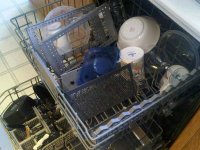I find laquer thinner easier to find in large quantities and lower cost than acetone over here. The stronger odor is remedied by better ventilation when working with the stuff. 😉
what kind of solvent is good for cleaning dried up heatsink compound? I use lots and lots of tissue paper. Very messy and too much work. Is there a better way?
what is "409"? is it some kind of dishwashing liquid?
what kind of solvent is good for cleaning dried up heatsink compound? I use lots and lots of tissue paper. Very messy and too much work. Is there a better way?
what is "409"? is it some kind of dishwashing liquid?
Ahhh... WD-40, one of the best cleaners that no one knows is a cleaner. Problem is you have to clean up after you clean up.
It's great for duct tape residue, too.
It's great for duct tape residue, too.
If you've tried everything and you still can't get your board clean, try a little mashed potatoes. Works like a charm. 😀
'409' (full name Formula 409) is a general purpose household cleaner, mainly used for cleaning kitchens or bathrooms. I keep it around to wash my hands (no running water in the shop).
For heavy heatsink compound, I scrape away as much as possible with heavy cardboard or plastic (like that used for credit cards). The residue cleans up easily with acetone (lacquer thinner worked as well). For PPI amps, acetone doesn't seem to work as well as it does on other amps so I remove the insulators (which need to be cleaned and reused), put them in a glass jar and soak them in a chlorinated solvent. The chlorinated solvent breaks down the compound very quickly. Having a sealed cover on the jar allows agitation/shaking which speeds up the process. When removed from the jar, the insulators essentially only need to be wiped dry.
PPI powdercoating is very easily damaged by solvents like acetone. It will instantly damage the finish on the sink. It's important to be VERY careful when using solvents on PPI amps. You can determine if the solvent is safe for the finish by testing it on the powdercoating that can't be seen when the cover is in place.
For heavy heatsink compound, I scrape away as much as possible with heavy cardboard or plastic (like that used for credit cards). The residue cleans up easily with acetone (lacquer thinner worked as well). For PPI amps, acetone doesn't seem to work as well as it does on other amps so I remove the insulators (which need to be cleaned and reused), put them in a glass jar and soak them in a chlorinated solvent. The chlorinated solvent breaks down the compound very quickly. Having a sealed cover on the jar allows agitation/shaking which speeds up the process. When removed from the jar, the insulators essentially only need to be wiped dry.
PPI powdercoating is very easily damaged by solvents like acetone. It will instantly damage the finish on the sink. It's important to be VERY careful when using solvents on PPI amps. You can determine if the solvent is safe for the finish by testing it on the powdercoating that can't be seen when the cover is in place.
Water does work well to clean dirty boards. Many people put the boards in a dishwasher. I've used a pressure washer many times. Removing the potentiometers is best.
Dishwasher is a wonderful thing when you're repurposing HP test equipment -- this HP401C was in really rough shape, so will become a fan cooled dummy load avec wattmeter. Don't tell the wife:
Attachments
I used to repair VCRs. If they had had a sandwich fed into them by a delightful toddler I regularly used to give them a bath in fresh water. As long as everything is dead and you dry everything before reapplying power, water will do no harm. Unless of couse it seeps into something that it shouldn't.
I powered up a PCB once that I had washed with water and thought had completely dried. Water stuck under the electrolytics quickly caused electrolysis and shorted the capacitor terminals. I had to remove the capacitors, scrub the crud off and solder them back. PCBs need to be dried thoroughly, and I don't see that happening sufficiently at 100F.
I would try mass airflow sensor cleaner in the spray can from auto parts stores, it dries super quickly and has no residue. I use alcohol on cotton swabs to clean boards, and it evaporates quickly to avoid damaging things. The dishwasher idea is great, just be sure to remove things that will hold water like the pots and leave them to dry thoroughly even after blowing any liquid from under the components with canned air.
I tried MAF sensor cleaner on a board constructed with rosin-core solder and I couldn't tell that it had done anything at all.
Knights Greeze-Off does a great job on nasty boards. It'll remove nicotine/smoke residue if you have a stinky board, but won't effect paint or ink. A Walter Bio circle cleaning tank will take off anything the Geeze-off won't. It doesn't effect paint or ink either. Follow with a good rinse in warm water, then re-rinse with distilled water. Distilled won't short out under the caps, if you mistakenly fire it up before it's dry.
I have used a product called "goof off" on at least 200 boards with no known issues. It works extremely well and I use Q-tips for cleaning the board of soot, dust, and solder flux.
The "goof off" also cleans thermal compound very well too!!!
The "goof off" also cleans thermal compound very well too!!!
- Status
- Not open for further replies.
- Home
- General Interest
- Car Audio
- Circuit Board cleaning
